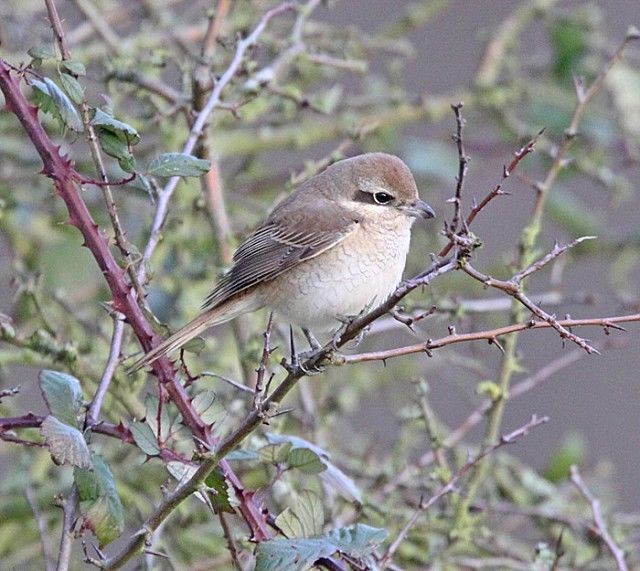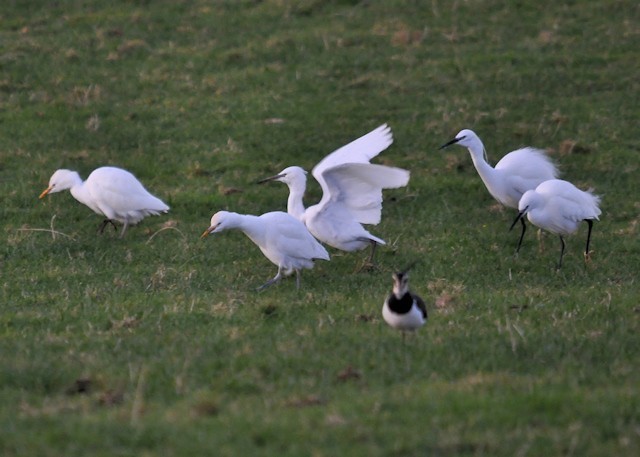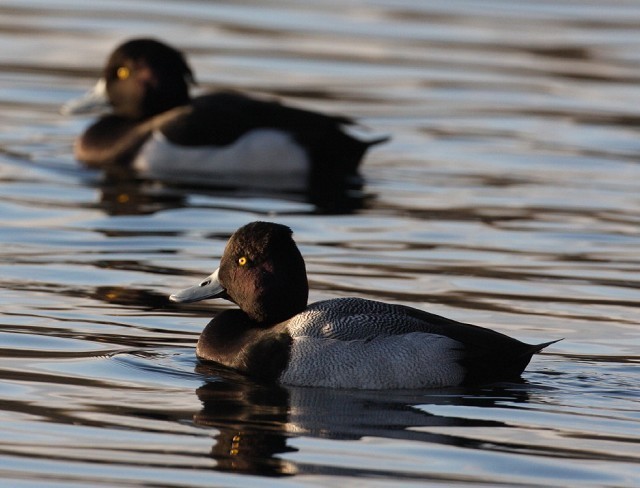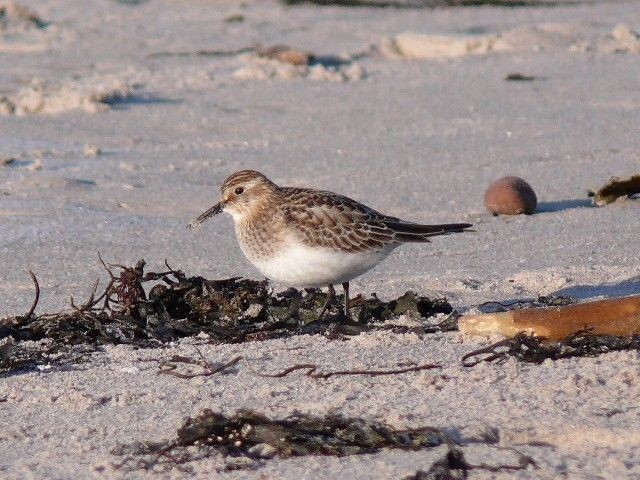The week at a glance
- Brown Shrike finally leaves Surrey
- Pacific Diver reported still in Cornwall
So the snow came after all. And so did some bitter northeast winds, freezing temperatures (nine below zero — or worse — in some areas of northern England and Scotland) and a spell of weather that looks set to ensure a truly white yuletide for some. There were one or two surprises too this week, with the discovery of a couple of very tidy wintering passerines, but the cold weather also seemed to account for one of the most watched birds of recent years.
The first-winter Brown Shrike at Staines Moor (Surrey) was last seen on 17th, just as the minus temperatures took hold. The bird had managed a record-breaking stay of 68 days since its discovery in the second week of October, and has been seen by thousands of birders, each one able to savour the fine points of this still problematic far-flung vagrant. Another long-distance traveller, the adult Pacific Diver in Cornwall, was still present, seen in Carbis Bay on 17th, with another sighting (only at "probable" status) on 19th.

Brown Shrike, Staines Moor, Surrey (Photo: Andrew Moon)
There was barely a seabird of any note this week: just one Balearic Shearwater was seen (off Jersey) and a couple of Little Auks included one off the Welsh coast, passing Llanddulas (Conwy) on 21st.
Worcestershire's first ever Glossy Ibis remained at Holt Fleet until 23rd, while the threesome in Somerset moved from Catcott Lows to Greylake on 20th and the single bird at Dungeness was still present to the weekend at least. Two Great White Egrets remained at Pitsford Reservoir (Northamptonshire) to 18th at least, with lingering singles still in Somerset, Warwickshire and Cumbria. On 18th Essex's Abberton Reservoir was host to a lone bird, which was then seen at Hanningfield on 20th. Another new bird on 20th was noted in Hertfordshire, at Tringford Reservoir (with another reported in Dorset, at Arne) and on 21st singles re-appeared in Leicestershire (at Swithland Reservoir) and Aberdeenshire (at Inchgarth NR). In Ireland, a Great White Egret was at Ballybay Wetland Centre (Co. Monaghan) on 19th.
Three Cattle Egrets were at Street (Somerset) on 20th and another trio were at Inchydoney Island (Co. Cork) on 19th–23rd (others in Cork were seen at Timoleague, Great Island and Rossleague). A single Cattle Egret was at Dungeness (Kent) at the start of the week, along with two in Hampshire and another reported belatedly from Gloucestershire on 16th. Two were also still on Jersey, at Grouville Marsh. Eight Spoonbills were seen in Cornwall (three in the south, five in the north), while the north of neighbouring Devon still had half a dozen at Isley Marsh. One bird was still around Scilly during the week, two were seen over Radipole Lake (Dorset) on 20th and singles were at Pagham Harbour (West Sussex) on 21st and Farlington Marshes (Hampshire) and Rainham Marshes (London) on 22nd. In Ireland, single Spoonbills were in Cork and Kerry. Only 10 Broadland Common Cranes were noted at the Stubb Mill roost this week (where have they all gone?) and two more Norfolk birds were over Weston Longville on 19th. Singles were seen in Devon, Somerset and Cork (at Kilcolman NR) towards the end of the week. In Durham, the White Stork (of unknown, but presumed suspect, origin) was at Great Lumley on 18th and Chester-le-Street on 20th, before moving into Northumberland on 22nd, flying over Newcastle-upon-Tyne. On 23rd, it was back down south, flying over Durham City.

Cattle Egret, Cobh, Cork (Photo: Ronan mclaughlin)

Spoonbill, Camel Estuary, Cornwall (Photo: Clare Stephenson)

Common Crane, Berrow, Somerset & Bristol (Photo: James Packer)
Two Snow Geese were seen over Glasson (Lancashire) on 20th and four remained at Aldcliffe Marshes to 21st. The Red-breasted Goose around both the Clyst and Exe Estuaries (Devon) was still present to 22nd, while one was seen over Lincolnshire and Nottinghamshire on 23rd (alongside Pink-footed Geese in the latter county). The two Red-breasted Geese on Jersey remained at St. Ouen's Pond until 23rd. In a poor week for goose sightings, just four single Black Brants were reported, in Dorset, Hampshire, Norfolk and Wexford. Elsewhere in Ireland, last week's new Richardson's Canada Goose was at Raghly (Co. Sligo) on 17th, with it or the original bird at nearby Ballintemple on 19th. Also on 19th, in Argyll, a Richardson's Canada Goose was at Loch Gruinart and a Lesser Canada Goose was at Skerrols (along with two hybrid youngsters). Over on Tiree, a Richardson's Canada Goose was still at Balephetrish on 21st but the biggest surprise was a flock of five presumed Lesser Canada Geese photographed on Loch Pottie, Mull on 18th. The birds only stayed until 10am before leaving — surely they won't take long to be found again?

Lesser Canada Goose, Loch Pottie, Mull, Argyll (Photo: Bryan Rains)
New drake Green-winged Teal were found at Wigan Flashes (Greater Manchester) on 19th and Hole Haven, Canvey Island (Essex) on 23rd and they were two of five birds seen this week. Two were in Scotland (at Caerlaverock and Loch Gruinart) with the other bird still on Inch Island Lake (Co. Donegal). In Norfolk, the drake American Wigeon remained at Welney until 17th at least.

American Wigeon, Welney WWT, Norfolk (Photo: Jonathan Smith)
In Wales, the drake Lesser Scaup was again on Cosmeston Lakes (Glamorgan) on 17th–19th and the 17th also saw the Channel Islands' first-ever Lesser Scaups still in place on Guernsey, at Grande Mere. The drake Ring-necked Duck was at Foxcote Reservoir (Buckinghamshire) on 20th–21st, while the female in Wales moved to Cwm Rheidol Reservoir on 23rd. In Ireland, another drake was at Glencar Lake (Co. Sligo) and a female was on Lough Gur (Co. Limerick) on 17th (having been first seen there in mid-November). Last week's three Ferruginous Ducks were this week's three Ferruginous Ducks too: drakes lingered at Pugney's CP (West Yorkshire) and Cheddar Reservoir (Somerset), with a female still at Abbotsbury (Dorset). In addition to these, the drake at Corbet Lough (Co. Down) was seen again, on 23rd, and a new drake was found in Norfolk on 22nd, at Barton Broad.

Lesser Scaup, Cosmeston Lakes CP, Glamorgan (Photo: Steve Hinton)
The regular, returning female Surf Scoter was still off Dawlish Warren this week and a drake was in the Bay of Kirkwall (Orkney) on 22nd. The drake King Eider at Burghead (Moray) was still present on 17th (possibly to 20th) and a first-winter drake was at Haroldswick, Unst (Shetland) on 22nd. In Dorset, the drake Hooded Merganser at Radipole Lake was still finding life on the south coast very much to his liking, still as dapper and handsome as ever, and still present on 20th.

King Eider, Burghead, Moray & Nairn (Photo: D Devonport)
Raptor of the week was undoubtedly the white Gyrfalcon (aged as a juvenile, sexed as a female) on the Gower Peninsula (Glamorgan) from 17th–20th. The bird was seen mostly around the Scurlage area, and may well have been present for a week or so beforehand. A probable Gyr was seen on Islay (Argyll) on 17th, and on 19th a white morph was reported over Crook (Co. Durham) and Newbiggin-by-the-sea (Northumberland). In Cambridgeshire, the male Rough-legged Buzzard returned to Coveney on 18th. This bird spent weeks in the area last winter, and was last seen on 20th April. In Perth & Kinross, a tagged White-tailed Eagle was at Vane Farm on 19th–23rd. All these would have been knocked into Santa's cocked hat if the wholly unconfirmed report of a male Pied Harrier in Essex (on 22nd) had got anywhere near firming up. Seen by a wildfowling non-birder, there's little, for the moment, to raise hopes beyond its being a commoner harrier species seen in unusually wintry conditions. For now, many will be leaving this well alone.
In Cumbria, at Port Carlisle, the first-winter Long-billed Dowitcher remained until 23rd, while Lothian's double act of wintering Nearctic shorebirds, the Barns Ness Baird's Sandpiper and the Aberlady Bay Lesser Yellowlegs were both still in place for another week.

Long-billed Dowitcher, Port Carlisle, Cumbria (Photo: Paul Kennedy)

Baird's Sandpiper, Barns Ness, Lothian (Photo: Kris Gibb)
The four Spotted Sandpipers (in Devon, Hampshire, Essex and Clyde) were all still present on 17th, with the Topsham bird remaining to 19th and the Abberton individual still around on 23rd.

Spotted Sandpiper, Killearn, Clyde (Photo: Ian Fulton)
At least a dozen Iceland Gulls were noted this week, and they included two at Peterhead (Aberdeenshire) on 23rd and two different birds at Chasewater Reservoir (Staffordshire) and Stromness (Orkney). Single juvenile Glaucous Gulls were seen in Devon, Kent, Cleveland, Durham, the Outer Hebrides and Shetland, with a second-winter in Moray and an adult in Orkney.

Iceland Gull, Stubber's Green, West Midlands (Photo: Jim Almond)
Familiar adult Ring-billed Gulls remained in Hampshire and Essex this week, while "new" adults were at Chew Valley Lake (Somerset) and Crosby (Lancashire) on 19th. Five adults were in Ireland this week, one each for Sligo, Limerick and Kerry, with two birds in County Cork, while in the north of the country, a second-winter was in Antrim (presumably one of last winter's youngsters back again).
At least 22 Caspian Gulls included a minimum of five birds in Northamptonshire, three of them at Ditchford on 22nd. Two birds were at Chasewater Reservoir (Staffordshire) on 20th and 23rd and further "twos" were at Dosthill Lakes (Warwickshire) on 18th and Foremark Reservoir (Derbyshire) on 21st. Most notable of all this week's cachinnans was undoubtedly the first-winter seen at Seaton (Devon) on 23rd, only the second record in the county this decade.
A male Siberian Stonechat was a tremendous inland winter find at Bevercotes Pit Wood (Nottinghamshire) on 17th. This popular and very handsome individual is only the third record of the year for this appealing form/subspecies/species (author and country-of-residence depending) and represents the first record for the county. Needless to say, it is also only one of a handful of British winter records, and it was still coping with the cold to 23rd. On the Isle of Wight, a Hoopoe seen near Brighstone on 16th October was, amazingly, seen again on 18th.

Siberian Stonechat, Bevercotes Pit Wood, Nottinghamshire (Photo: Craig shaw)
It's been a (surprisingly) good week for Richard's Pipits, with four birds seen. Two were in the far southwest, on St. Mary's (Scilly) and at Sennen (Cornwall), with the others seen in Glamorgan (at Ogmore-by-Sea) and in Cheshire (at Neston Marsh).

Richard's Pipit, Southerndown, Glamorgan (Photo: Steve Hinton)
Despite the harsh conditions, very few Waxwings have been reported this winter, but a handful of flocks were reported this week. A flock of 28 were at Kirkliston (Lothian) on 18th, while on 21st there were 19 at Ballycoolin (Co. Dublin) and six were reported in Cheshire, near Northwich. A dozen or so were seen at Linlithgow Loch (Lothian) on 22nd, with five in Northumberland on the same date and 10 at Musselburgh (Lothian) on 23rd.
The week's four Great Grey Shrikes included the regular bird at Holmsley Inclosure (Hampshire) on 17th–23rd, while others were seen near the Usk Estuary (Cumbria) on 17th and Ash Ranges (Surrey) and Black Down (Somerset), both on 20th.
Two Penduline Tits remained at Dungeness until 17th at least, and a single Serin was still at Rainham Marshes (London) until 20th. The final bird of the review was another surprise package: the Highland Little Bunting, found at Dunnet Bay on 20th and still present on the following three days (almost mirroring the bird that was seen in the county for a couple of days in February 2008).
This is the last weekly review of 2009; an extensive review of the birding year will appear next week. The review will return in its regular format early in the New Year. All that remains is to wish all review readers a very Happy Christmas and a peaceful 2010.
Photo of the Week

Peregrine Falcon, Castletown, Isle of Man (Photo:
Pete Hadfield)
Although we receive quite a number of images of Peregrine Falcons, it's only rarely that the images show the falcons with their prey, and even rarer to be able to make out the victim clearly. This week, Isle of Man-based bird photographer Pete Hadfield has submitted a well-lit shot of one of these magnificent, muscular birds astride an unfortunate Oystercatcher in an open, short-grass setting. Despite the extreme distance, Pete was able to use a very long focal length lens (a 35mm equivalent of 1600mm, giving over 30x magnification) to capture the scene. The combination of setting, lighting and colours make the birds stand out clearly, and then the positions of the birds and the timing of the shot came together to sum up the event perfectly. Pete has been sending us high-quality images of Manx birdlife for over five years, so it's great to be able to finally award him a well-deserved Photo of the Week.
Other notable photos

Song Thrush, undisclosed site, Lancashire (Photo:
David Cookson)

Grey Heron, Brandon Marsh NR, Warwickshire (Photo:
Tom Melton)

Hoopoe, Portugal (Photo:
James Wood)

Red Grouse, Lammermuir Hills, Lothian (Photo:
Ron McCombe)

Barn Owl, undisclosed site, Lancashire (Photo:
David Cookson)

Mediterranean Gull, Mumbles Head, Gower, Glamorgan (Photo:
Jim Almond)

Tawny Owl, Ipswich, Suffolk (Photo:
Carl Wright)

Mandarin Duck, Doncaster, South Yorkshire (Photo:
Brian Irvine)

Black Kite, India (Photo:
Dave Williams)

Marsh Harrier, Minsmere RSPB, Suffolk (Photo:
Jon Evans)

Bearded Tit, Minsmere RSPB, Suffolk (Photo:
Jon Evans)

Southern Grey Shrike, Spain (Photo:
James Wood)

Teal, Cley Marshes NWT, Norfolk (Photo:
Amanda Hayes)

Bullfinch, Llandrindod Wells, Powys (Photo:
Kev Joynes)

Secretary Bird, Kenya (Photo:
Mike Warren)

Robin, Enderby, Leicestershire and Rutland (Photo:
Paul Riddle)

